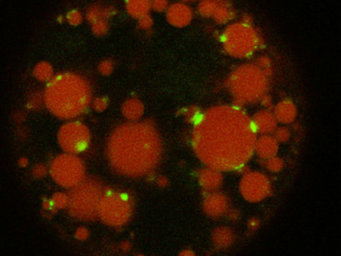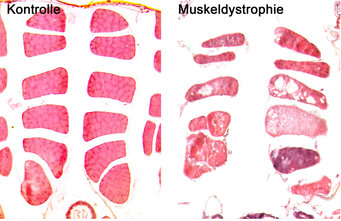
Why do scientists investigate flies?
Outwardly, fruit flies and humans have little in common. It is all the more astonishing that roughly 60 percent of the fly's genes can also be found in humans in a similar form. Many insights gained from researching with Drosophila therefore provide important indications of how a process might unfold in mammals or humans.
High genetic similarity with mammals

Analyzing the genome of a fly is easier than of a mouse or human, as it only consists of eight chromosomes. By way of comparison: the genome of a mouse consists of 40 chromosomes and that of humans 46. The genome of a fly was one of the first to be decoded by scientists, a task already completed by the year 2000. Drosophila possesses around 15,000 genes containing information for proteins. By way of comparison: humans and mice both possess around 24,000 genes. A comparison of the genome of humans and flies shows that
- around 75 percent of the genes which are known to cause illnesses in humans, also occur in flies.
- Drosophila possesses more than 90 percent of the genes that can trigger cancer in humans.
Thanks to this high degree of genetic similarity, scientists can use flies to examine which function genes possess that may lead to diseases in humans.
Appropriate animal holding
Fruit flies do not require much space and make few demands on their environment: a small plastic or glass vessel and the right nutrition suffice. If the correct temperature and humidity levels are also maintained, they can be kept without problems and will multiply.
High fertility and fast development
Under optimum conditions, the Drosophila female will lay up to 100 eggs a day. Consequently, researchers have a large number of insects available within the shortest amount of time.
Fully formed flies develop from the eggs in one to two weeks depending on the ambient temperature: at 25 degrees, this takes nine to ten days. During this period, the insects turn into an embryo within one day. Thereafter, they pass through three larval and one pupal stage until they become fully-formed flies. In this way, around 25 generations of flies can be cultivated per year. By way of comparison: laboratory mice only produce four to six generations per year.
Ease of genetic modification

Researchers can modify the genome of Drosophila relatively easily. For a long time, this was accomplished with the aid of substances or radiation that modified the genetic code. Today, scientists frequently use the genetic scissors Crispr-Cas9, for example, to change or switch off specific sections of the genome in a fly cell. The so-called UAS/Gal4 system can also be used to activate genes at any desired moment and in any tissue. To do so, scientists inject the modified sections into the cells of a fly embryo shortly after fertilization. Thanks to these fast and affordable methods, there are now several tens of thousands of genetically modified Drosophila strains in the world – many more than of any other organism.
Ease of examination
It is also an advantage that the flies lay eggs. As a result, the young develop outside their mother's body, enabling scientists to more easily observe and genetically modify the growing embryo. Different genetic lines can therefore be bred from individuals with changes to their genome (mutations) more rapidly than with other animals.

